
The Kanangra-Boyd National Park is a protected national park that is located in the Central Tablelands region, west of the Southern Highlands and Macarthur regions, in New South Wales, in eastern Australia. The 68,660-hectare (169,700-acre) national park is situated approximately 180 kilometres (110 mi) south-west of Sydney and is contiguous with the Blue Mountains National Park and the Nattai National Park. The park was established in 1969.
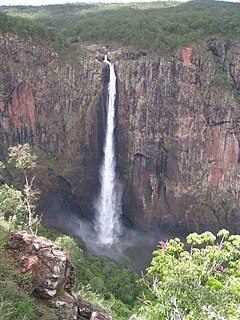
The Wallaman Falls, a cascade and horsetail waterfall on the Stony Creek, is located in the UNESCO World Heritage–listed Wet Tropics in the locality of Wallaman, Shire of Hinchinbrook in the northern region of Queensland, Australia. The waterfall is notable for its main drop of 268 metres (879 ft), which makes it the country's tallest single-drop waterfall. The pool at the bottom of the waterfall is 20 metres (66 ft) deep. An estimated 100,000 people visit the waterfall annually.
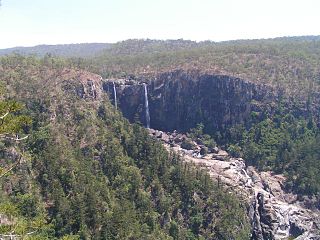
The Herbert River is a river located in Far North Queensland, Australia. The southernmost of Queensland's wet tropics river systems, it was named in 1864 by George Elphinstone Dalrymple explorer, after Robert George Wyndham Herbert, the first Premier of Queensland.
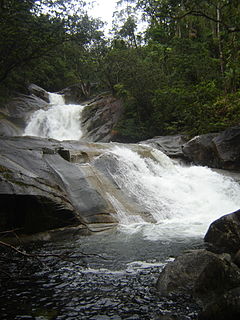
The Josephine Falls is a tiered cascade waterfall on the Josephine Creek located in Wooroonooran, Cairns Region in the Far North region of Queensland, Australia.

The Malanda Falls is a cascade waterfall on the North Johnstone River, located in the Tablelands Region in the Far North of Queensland, Australia.

The Herbert River Falls is a plunge waterfall on the Herbert River that is located in the UNESCO World Heritage–listed Wet Tropics in the Far North region of Queensland, Australia.

The Russell Falls, a tiered–cascade waterfall on the Russell Falls Creek, is located in the Central Highlands region of Tasmania, Australia.
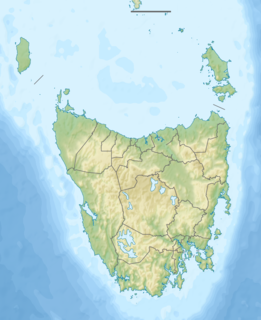
The Montezuma Falls, a horsetail waterfall on a minor tributary to the Pieman River, is located on the West Coast Range of Tasmania, Australia.

The Liffey Falls, a series of four distinct tiered–cascade waterfalls on the Liffey River, is located in the Midlands region of Tasmania, Australia.

The Dip Falls, a cascade waterfall over cubic-basalt formed rocks on the Dip River, is located in Mawbanna in the North West region of Tasmania, Australia.

The Guide Falls and Upper Guide Falls, a tiered–cascade waterfall on the Guide River, is located in the North West region of Tasmania, Australia.

The Delaneys Falls, dually–named as the Preston Falls, a plunge waterfall on an unnamed watercourse, is located in the North West region of Tasmania, Australia.
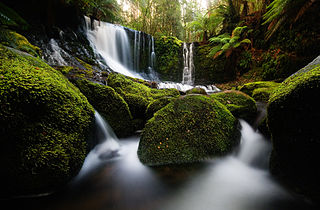
The Horseshoe Falls, a tiered–cascade waterfall, is located in the Central Highlands region of Tasmania, Australia.

Round Mountain, a mountain of the Snowy Range, a spur of the Great Dividing Range, is located on the Northern Tablelands in the New England region in New South Wales, Australia.

The Tully Falls, a horsetail chute waterfall on the Tully River, is located in the UNESCO World Heritage–listed Wet Tropics in the Far North region of Queensland, Australia. It formed the eastern boundary of the Dyirbal.

The Lady Barron Falls, a tiered–cascade waterfall on the Lady Barron Creek, is located in the Central Highlands region of Tasmania, Australia.

The King George River is a perennial river located in the Kimberley region of Western Australia, in Australia.
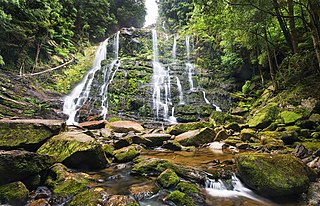
The Nelson Falls, a cascade waterfall, is located in the UNESCO World Heritage–listed Tasmanian Wilderness, in the West Coast region of Tasmania, Australia.
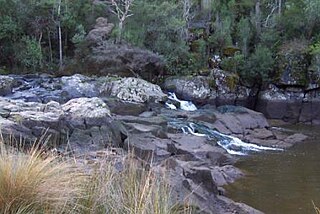
The Supply River is a perennial river located in the northern region of Tasmania, Australia.

The Detention Falls, a cascade waterfall on the Detention River, is located at Milabena in North West Tasmania, Australia.























